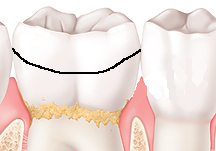Tooth equator

The tooth equator is the largest circumference of a tooth in the area of the tooth crown .
A distinction is made between the anatomical tooth equator (that is the largest circumference of a tooth crown, based on the longitudinal axis of the tooth) and the prosthetic tooth equator (that is the largest circumference of a tooth crown, based on the direction of insertion of a partial denture ).
The anatomical tooth equator ( for mandibular molars ) is about 2 mm above the gum line (for maxillary molars it is about 2 mm below). Approximally , the tooth equator touches the neighboring teeth in a point-like manner (contact point).
In order to determine a common insertion direction for the holding elements of a partial prosthesis, the prosthetic tooth equator can deviate considerably from the anatomical one when the teeth are tilted.
To determine the prosthetic tooth equator, the teeth are precisely measured with a parallelometer and the tooth equator is marked. The area below the tooth equator is known as the infra bulge , the area above the tooth equator as the supra bulge . Only the infrarea of the teeth can give a prosthesis the necessary support.
See also
swell
- Walter Hoffmann-Axthelm : Lexicon of Dentistry , Quintessenz-Verlag, Berlin
- Dental knowledge lexicon: equator / tooth equator

